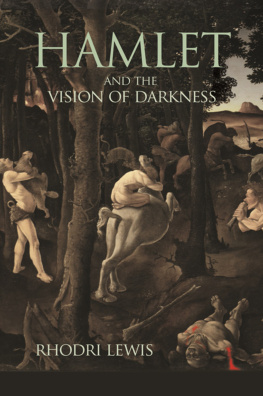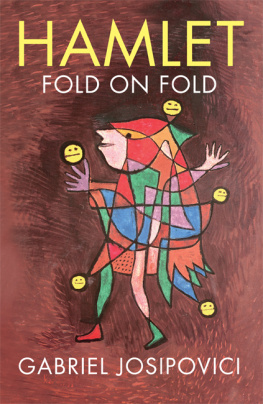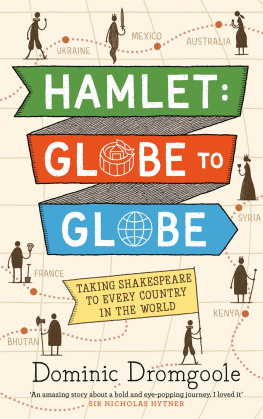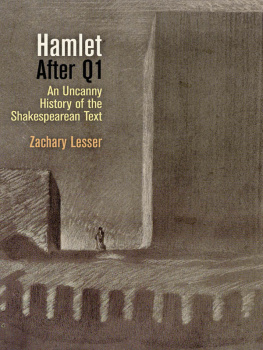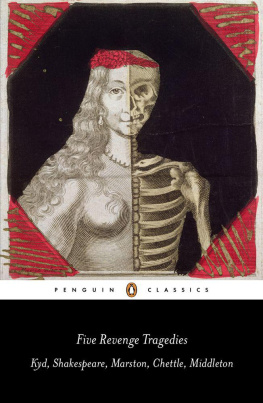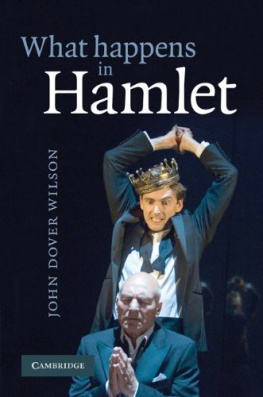Contents
Page List
Guide
HAMLET AND THE VISION OF DARKNESS
Hamlet and the Vision of Darkness
Rhodri Lewis
PRINCETON UNIVERSITY PRESS
PRINCETON & OXFORD
Copyright 2017 by Princeton University Press
Published by Princeton University Press,
41 William Street, Princeton, New Jersey 08540
In the United Kingdom: Princeton University Press,
6 Oxford Street, Woodstock, Oxfordshire OX20 1TR
press.princeton.edu
Cover art: Piero di Cosimo (Piero di Lorenzo di Piero dAntonio), A Hunting Scene, c. 14941500. Gift of Robert Gordon, 1875 / The Metropolitan Museum of Art, New York
Cover design by Leslie Flis
Excerpt from Sprich auch du, Paul Celan, Von Schwelle zu Schwelle 1955, Deutsche Verlags-Anstalt, Munchen, in der Verlagsgruppe Random House GmbH.
Excerpt from Seven Types of Ambiguity copyright William Empson, 1930.
Excerpt from How It Is by Samuel Beckett, English translation copyright 1964 by Grove Press, Inc. Used by permission of Grove/Atlantic, Inc. and Faber & Faber Ltd. Any third party use of this material, outside of this publication, is prohibited.
Excerpt from Good Writers and Good Readers from Lectures on Literature by Vladimir Nabokov. Copyright 1980 by the Estate of Vladimir Nabokov. Reprinted by permission of Houghton Mifflin Harcourt Publishing Company. All rights reserved.
All Rights Reserved
First paperback printing, 2020
Paperback ISBN 978-0-691-20451-2
The Library of Congress has cataloged the cloth edition as follows:
Names: Lewis, Rhodri, 1976 author.
Title: Hamlet and the vision of darkness / Rhodri Lewis.
Description: Princeton : Princeton University Press, 2017. | Includes bibliographical references and index.
Identifiers: LCCN 2017003227 | ISBN 9780691166841 (hardback : acid-free paper)
Subjects: LCSH: Shakespeare, William, 15641616. Hamlet.
Classification: LCC PR2807 .L47 2017 | DDC 822.3/3dc23 LC record available at https://lccn.loc.gov/2017003227
British Library Cataloging-in-Publication Data is available
This book has been composed in Miller
Printed on acid-free paper.
Printed in the United States of America
For Sarah, and for Max
quid dubitas quin omnis sit haec rationis potestas, omnis cum in tenebris praesertim vita laboret? nam vel uti pueri trepidant atque omnia caecis in tenebris metuunt, sic nos in luce timemus interdum nihilo quae sunt metuenda magis quam quae pueri in tenebris pavitant finguntque futura. hunc igitur terrorem animi tenebrasque necessest non radii solis neque lucida tela diei discutiant, sed naturae species ratioque.
LUCRETIUS, DE RERUM NATURA
Falsehood is so easy, truth so difficult. The pencil is conscious of a delightful facility in drawing a griffinthe longer the claws, and the larger the wings, the better; but that marvellous facility which we mistook for genius is apt to forsake us when we want to draw a real unexaggerated lion. Examine your words well, and you will find that even when you have no motive to be false, it is a very hard thing to say the exact truth, even about your own immediate feelingsmuch harder than to say something fine about them which is not the exact truth.
GEORGE ELIOT, ADAM BEDE
Wahr spricht, wer Schatten spricht.
PAUL CELAN, SPRICH AUCH DU
CONTENTS
ILLUSTRATIONS
PREFACE AND ACKNOWLEDGEMENTS
THE PROXIMATE ORIGINS of the work before you lie in two seminar papers written in early 2011. The first was delivered in Oxford and comprised a preliminary version of what is now . In the Q&A session that followed, two colleagues confirmed one another in the view that as Hamlet speaks of such weighty matters in such lovely verse, it was self-evidently perverse of me to have argued that Shakespeare portrays him as poetically inept.
Each response left me somewhere between speechless and clutching at straws. How to establish that Shakespeare knew what he was doing when putting particular words and assumptions in Hamlets mouth? How, in the face of such indifference to the distinction between the poet and the mere versifier of which the early moderns made so much, to escape the conclusion that Hamlet has fallen victim to the Mona Lisa cursethat its celebrity has taken it beyond the scope of intelligent discussion? Lesprit de lescalier is generally the cause of frustration or wryly amused regret. In this instance, it also served as an embarkation point. Initially, my destination was a study of Shakespeares works read alongside, and most likely against, early modern notions of psychology and cognition. As I researched the topic in greater detail, this destination began to shift. I was surprised to find myself returning again and again to Hamlet. Furthermore, to find that as I attempted to pursue my readings of Hamlet to their conclusions, many of them demanded that I fundamentally recalibrate my understanding not only of the plays action, but of what its action might be said to mean.
Thus the idea of this book began to take shape. Certainly, it has been written with a view to introducing aspects of Shakespeares work that are unfamiliar or misunderstoodincluding his engagements with what one might call early modern cognitive theory. I also hope to have advanced by example the related methodological claim that reading widely, diligently, and imaginatively (and sometimes in languages other than English) is a good and necessary thing in approaching any work of early modern poetry or drama. But the governing preoccupations of Hamlet and the Vision of Darkness lie elsewhere: unabashedly, it is an exercise in literary criticism. Rather than constraining Shakespeare to furnish examples with which to illustrate or to challenge the history, theory, or politics of x, this book allows his writing to take precedence over the contexts in which it can be situated; even the worthiest and most arresting of them are admitted only when helping to explicate the poetic and dramatic phenomena of his work. The challengeat times, it bears the weight of a paradoxis that without the curiosity and scholarly acumen required to sift the various contexts (cultural, social, intellectual, political, religious, economic, formal, etc.) with which Shakespeares writing intersects, it is impossible fully to appreciate the scale of his poetic and dramatic achievement. My readers will determine if and to what extent I have succeeded in meeting this challenge. I have sought to persuade, and sometimes to provoke, them into reconsidering much of what they think they know about this most familiar of plays.
Completing this book has led me to incur a large number of scholarly, institutional, and personal debts. It is a pleasurable duty to acknowledge them. Auden thought it likely that more nonsense has been talked and written, more intellectual and emotional energy expended in vain, on the sonnets of Shakespeare than on any other literary work in the world. With some trepidation, I wonder if that distinction doesnt in fact belong to Hamlet. Its just that as more seems to have been written on Hamlet than on any other work of non-religious literature, it can be tricky to disentangle the flimsy or the fanciful from the astute. Unable to locate the crown jewels, its students have frequentlyfar too frequently for comfortsurrendered themselves to the forgotten butterfly of revelation. Caveat scriptor. Although my notes and bibliography attest that I have learned from scholars and critics of many divergent approaches (and although my introduction maps the field of

